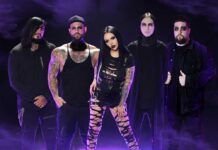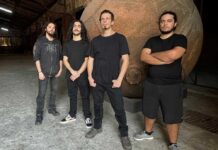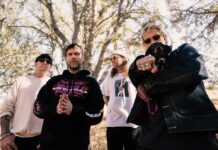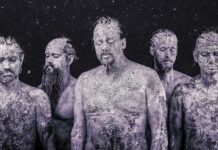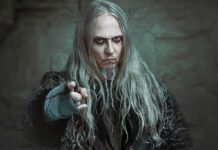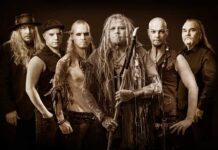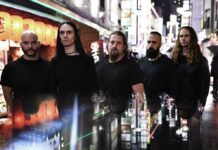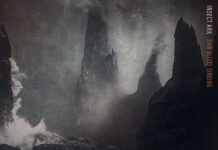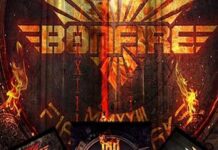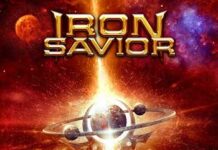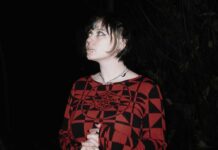
INTERVIEW WITH TRISTAN SHONE BY JOE DALY
PHOTOGRAPHS BY BECKY DIGIGLIO
For nearly 20 years, the sonic steamroller known as Author & Punisher has continued to release a mesmerizing body of music that is as innovative as it is brutal. Synthesizing the cold steel precision of industrial with layers of drone, metal, electronica, and noise, Author & Punisher has charted a dramatic evolution from the extreme experimentalism of 2005’s The Painted Army to the melodic grandeur of 2018’s Beastland.
The one-man alter ego of artist and mechanical engineer Tristan Shone, Author & Punisher’s live show has achieved a fervent, cult-like status, with Shone surrounding himself with a futuristic console of machines, controllers, and microphones that he built himself. Coming off of a 2020 tour supporting Tool, Shone withdrew to his hometown San Diego where he began work on Krüller, his eighth full-length album. Inspired not only by the chaos of the pandemic but by the incendiary political landscape and the eerily prescient sci-fi novels of Octavia Butler, his latest effort sees Shone notching new creative highs across the board.

You wrapped up the Tool tour right before the pandemic hit. What’s it been like for you since?
I’ve been all over the place during the pandemic, but I’ve been fortunate to have a pretty flexible job working in a lab at UCSD. I’m a mechanical engineer there and I work with a bunch of scientists who work on Alzheimer’s and things relating to the brain. Coming off of my tour with Tool, it was pretty much the end of an album cycle, so I figured I’d just start writing some music and surf a little bit. But I did miss 42 shows that year due to the pandemic.
“I’M ALWAYS LAYERING THINGS WITH BIG DRONES, DISTORTION, AND A BIG WALL OF SOUND, AND I REALIZED THAT WE COULD DIAL SOME OF THAT BACK A BIT.”
You build machines for brain research?
There are only certain places in the world where you can actually get a human brain that’s been biopsied and infected with Alzheimer’s because you have to pull it out of a live person’s head and that’s not something they like to do. We have some old samples and we look at the plaques that form in your brain. I’m the enabler for the electrical gadgetry that they install in electron microscopes. I don’t handle the direction of the scientific research. I work for those people. They might need a new way to view a sample through the microscope and that’s where I come in. I like to work more with electromechanical gadgets.
What was your approach to Krüller when you first started writing for it?
While on tour with Tool, we recorded a lot of those shows and I listened to myself every night. I was able to edit those tracks down and release them as a live album. It was a very honest look in the mirror for me. There were some really good things and there were some things that I wanted to change for the next record. And one of them was some of the abrasiveness. I’m always layering things with big drones, distortion, and a big wall of sound, and I realized that we could dial some of that back a bit.
Krüller is a major step away from the more chaotic, industrial rock foundations of your early output, moving towards heavily melodic. How intentional was that?
It’s funny because I feel like the last album, Beastland, could have sounded more like this. Jason Begin, the other guy who helped me produce this, said, “We’re going to mix this ourselves and keep it in house.” It allowed us to complete the process over a span of months rather than pay someone else for seven days of mixing, not knowing if you’re going to nail it. So, I got to mix it the way that I want.
Where can we hear an example of something you added from this perspective?
With the low end—for a band, this would be the bass guitar, but for me it’s a sub-oscillator and a synthesizer with some distortion that I run through speakers—I was able to make that sound the way that I wanted, which was wide and having a lot of girth, covering a huge frequency range. I think that sometimes bands try to carve out narrow frequency bands for their instruments. I spent a couple of months getting that tone, and so with the vocals, I didn’t feel the need for my voice to be so overwhelming because the low end was so heavy.
“I WAS ABLE TO MAKE THAT SOUND THE WAY THAT I WANTED, WHICH WAS WIDE AND HAVING A LOT OF GIRTH, COVERING A HUGE FREQUENCY RANGE.”
The vocals on this record are clean across the board, which isn’t new territory for you, but you’re operating on a whole new level here.
I’ve had melodic vocals consistently on all records. Now, whether that’s been the majority of vocals on each record or not is a different story. Touring with Tool, I got to listen to Maynard’s in-ear mix for a couple of songs one night. I was talking to their sound engineer, and there are some parts in my music where things get so chaotic that it’s hard to find the right pitch in my tone. It’s not that I can’t hit the pitch, it’s just that there’s so much noise happening, it’s like, “Where the hell is it?” Those guys really helped me clean up my in-ear mix by shelfing off the low end, so that anything below 120hz I won’t hear in my ear because you already feel it in your chest. On Maynard’s mix, there’s very little low end to interfere with his singing as he hears it through his ears. So, that’s what I started doing. Suddenly, after EQ-ing my voice better, I could hear everything else better, and when I recorded the vocals in the studio for the new album, I was much more confident hitting all of those pitches with the heaviness in the sound.
Tell us about the new song “Blacksmith.”
There are a lot of collaborations on this album and that one was with Jason Begin, who goes by Vytear, who’s much more of what they call IDM—intelligent dance music, like Aphex Twin, Squarepusher, and these very aggressive electronic, breakcore drum and bass acts—all the shit I love about 90s rave culture. If you think about heavier electronic music now, it’s like Perturbator, Ministry, Godflesh, and other bands like that. We wanted to do a collaboration where the heavy first half could morph into more of an upbeat, electronic thing, which is going to be hard to pull off live because so much of it was written by Jason on sequencers and samplers.

And there’s a Portishead cover on Krüller!
Portishead, being trip-hop, was definitely from the rave culture. They were like the apocalyptic doom band for electronic music. And it has a lot of crossover with the sound that the new album has, which is heavy and low but also lighter on the top end, with the synths and vocals. I have other songs like this that are out of left field. I have one by Andrea Boccelli that has the gnarliest doom riff ever. I’m going to do it someday, and it’s going to throw people for a loop! But I’ll have to sing in Italian and I would fuck it up (laughs).
“ESTABLISHING SOME KIND OF FEEL FOR A MORE METAL VOCAL STYLE BUT STILL HAVE THAT AUTHOR & PUNISHER SOUND, THAT WAS THE BIGGEST HURDLE.”
To what extent, if any, were you influenced by 90s alt-metal?
Maybe not 90s alt, but I was really into bands like Quicksand. And when Godflesh briefly broke up and Justin Broadrick formed Jesu, that was super heavy, but his vocals were more mellow and I always liked his lighter vocals. So, I think that planted the seed for me. And some of the later Neurosis stuff, like the track “The Last You’ll Know,” off of Times of Grace. There was something so heavy about that track, but also with the bagpipes, it’s one of those songs where you can get emotional listening to it, without being emo. So, I don’t know about alt music but maybe the lighter side of Godflesh and Neurosis.
What was your biggest challenge in writing this record?
I thought it was going to be the vocals because once I wrote the tracks, I had these vocal melodies in my head. For example, on “Drone Carrying Dread,” the first single, I thought this is either going to sound how I wanted it or it will sound like Creed or like cowboy Metallica, when they did some of that shit. Luckily, it didn’t sound like that, but in my head, I knew that it could have gone in that direction. So, establishing some kind of feel for a more metal vocal style but still have that Author & Punisher sound, that was the biggest hurdle.
Krüller references the works of Olivia Butler. In Parable of the Talents, which she wrote in 1998, one of the characters is US Senator Andrew Jarret, whose presidential campaign slogan is “Make America great again” and who wanted to rid the United States of all non-Christian faiths. How did this series of books inform the new album?
I wish I’d known about her before. I’d been reading sci-fi and dystopic novels forever. I grew up with that stuff. So when the pandemic started, everyone was talking about that book. The political thing, for sure, that’s definitely a parallel. But for me, it was more of when, in The Parable of the Sword, she was in the walled city and the clock was ticking on how long they could stay there and she was learning on her own how to live off of the earth. She had a Native American book on how to live off of seeds, roots, and vegetables, how to live in the wild, how to use a gun. I remember starting from the beginning of the pandemic, more and more you’d see people driving around in these trucks that started looking like survival vehicles. They had all these gas tanks all over them and they were tactically colored in tan and grey. They looked like military colors. They’re not militias, but those vibes were there. People were ready to explode and go live in the desert. So, for sure, that was the vehicle on the album cover. The artist Andres Zacco and I met many times over drinks and came up with this world that was where we’d be in 15 or 25 years. It was a more romantic and stylish conception, not like Road Warrior or Dune. The vehicle that he came up with and some of those landscapes, they were inspired by the novels.
Given how prescient Butler’s novels proved to be, do you think the United States could follow a similar trajectory?
Yeah, but I try to be a little more hopeful. There are a lot of people out there trying to change things and putting a lot of effort in. I’d like to give them the benefit of the doubt for all of their hard work, whether it’s climate or politics or whatever. But yeah, I read an article in the Guardian that talked about civil war and what it might look like, and they were comparing what’s happening here to Northern Ireland, where it was insurrectionist warfare and bombing buildings and things like that. It’s unlikely that we’d have some armed group take over the capitol building, the military, and the entire government, but it’s sad to think about. I suppose it could happen.
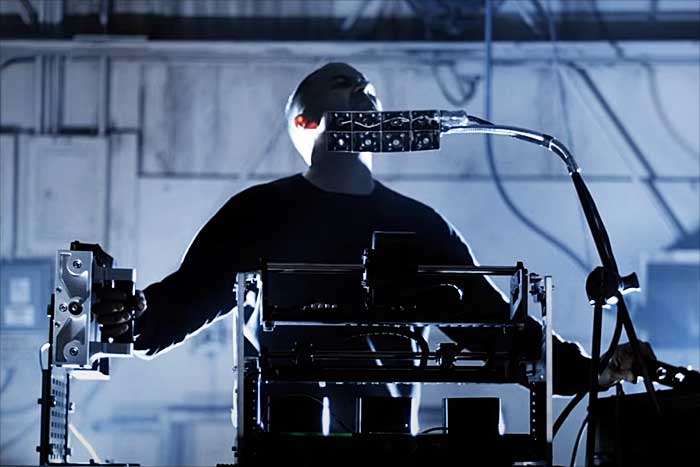
You also started a new business, making equipment like the stuff you’ve built for yourself that you use on tour. How’s that been for you?
It’s something that I’ve wanted to do for a long time. I’m not in my 20s anymore. Now I’m a bit smarter about jumping into shit like that. I found another engineer and Jason Begin, the synth guy, and we’ve taken three of my instruments and come up with cleaner, more elaborate versions of them. We’re starting with a knob that’s made out of wood, concrete, or stone and a bunch of outputs, ball bearings, and shafts—something that can spin for a very long time. Outputs for modular synths, MIDI, OSC, network, and then we’ve got another one with two sliding keys and another that’s a spin and slide chain. It’s about really hardcore controllers for software and hardware.
“WE’VE TAKEN THREE OF MY INSTRUMENTS AND COME UP WITH CLEANER, MORE ELABORATE VERSIONS OF THEM.”
Who’s the customer for that sort of gear?
Industrial people like myself are probably not a big part of the customer base. We’re looking more for electronic musicians, modular synth musicians, techno DJs, and such who want to incorporate really tactile, physical controllers into their setup. Most of the time they’re just doing knob twiddling and button pressing. These are controllers. One of them is two sliding keys and two ball bearings that slide and each key moves. So, it slides about 13 inches and you can press it and it has touch sensitivity. All of this is made with aluminum and steel—stuff that you typically don’t have on these software controllers. It’s about being able to interact with something that’s made of wood, steel, and aluminum while playing electronic live music. Hopefully, it will make people express themselves more intimately, like you might do with a guitar.
You were forced to cancel a February UK tour and you’ve postponed some mainland EU shows until March. Beyond that, what’s in store for the coming year for Author & Punisher?
I hope it’s touring. I’m sure we’ll be able to do some of these US shows. Then in the fall, it’s with Perturbator and Health, which is a nice crossover of electronic music and heavier stuff, and that’ll be six weeks of a full bus tour of Europe. At the very least, I hope that happens. I’m trying not to plan these six week US tours. I’m trying to book these smaller, two week ones because I feel like it’s just a wise move. Because who the hell knows what’s going to happen. But there is a San Diego show coming up in May, and that will be the first San Diego show. I’m pretty confident about the US shows.


